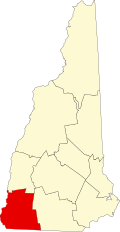Sawyers Crossing Covered Bridge | |
 Sawyers Crossing/Cresson Bridge | |
| Location | Sawyers Crossing Road over the Ashuelot River, Swanzey, New Hampshire |
|---|---|
| Coordinates | 42°53′10″N72°17′12″W / 42.88611°N 72.28667°W |
| Area | less than one acre |
| Built | 1859 |
| Architectural style | Town truss |
| NRHP reference No. | 78000211 [1] |
| Added to NRHP | November 14, 1978 |
The Sawyers Crossing Covered Bridge , also known as the Cresson Bridge, is a wooden covered bridge carrying Sawyers Crossing Road over the Ashuelot River in west Swanzey, New Hampshire. Built in 1859 to replace an older bridge, it continues to serve as a part of Swanzey's transportation network, and is one of the state's few surviving 19th-century covered bridges. It was listed on the National Register of Historic Places in 1978. [1]



